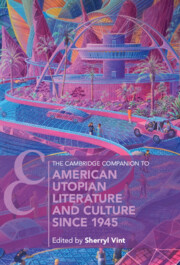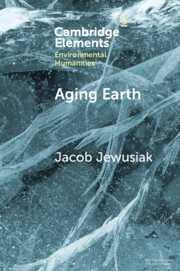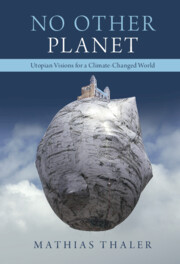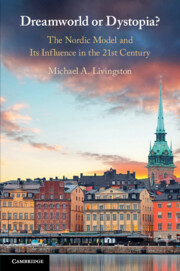28 results
Chapter 2 - American Futures
-
-
- Book:
- The Cambridge Companion to American Utopian Literature and Culture since 1945
- Published online:
- 09 May 2024
- Print publication:
- 16 May 2024, pp 41-61
-
- Chapter
- Export citation

The Cambridge Companion to American Utopian Literature and Culture since 1945
-
- Published online:
- 09 May 2024
- Print publication:
- 16 May 2024
Chapter 23 - Parable Series (1993, 1998): Octavia E. Butler
- from Part III - Case Studies
-
-
- Book:
- The Cambridge Companion to the Twentieth-Century American Novel and Politics
- Published online:
- 07 October 2023
- Print publication:
- 12 October 2023, pp 330-340
-
- Chapter
- Export citation
Chapter 8 - Biodystopia
- from Part IV - Genome Time
-
- Book:
- Literature, Science, and Public Policy
- Published online:
- 03 August 2023
- Print publication:
- 17 August 2023, pp 163-181
-
- Chapter
-
- You have access
- Open access
- HTML
- Export citation
Chapter 5 - The Modern Synthesis
- from Part III - The Modern Synthesis
-
- Book:
- Literature, Science, and Public Policy
- Published online:
- 03 August 2023
- Print publication:
- 17 August 2023, pp 97-119
-
- Chapter
-
- You have access
- Open access
- HTML
- Export citation

Aging Earth
- Senescent Environmentalism for Dystopian Futures
-
- Published online:
- 12 July 2023
- Print publication:
- 03 August 2023
-
- Element
- Export citation
17 - Killing for the Hindu Nation
- from Part III - Religious Nationalism
-
-
- Book:
- The Cambridge Companion to Religion and War
- Published online:
- 04 May 2023
- Print publication:
- 11 May 2023, pp 349-368
-
- Chapter
- Export citation

No Other Planet
- Utopian Visions for a Climate-Changed World
-
- Published online:
- 07 October 2022
- Print publication:
- 22 September 2022
Chapter 14 - Speculative Fiction and Post-Capitalist Speculative Economies: Blueprints and Critiques
- from Part II - Contemporary Critical Perspectives
-
-
- Book:
- The Cambridge Companion to Literature and Economics
- Published online:
- 28 July 2022
- Print publication:
- 11 August 2022, pp 227-242
-
- Chapter
- Export citation
10 - Climate on Screen
- from Part III - Ways of Telling Climate Stories
-
-
- Book:
- The Cambridge Companion to Literature and Climate
- Published online:
- 31 March 2022
- Print publication:
- 07 April 2022, pp 162-176
-
- Chapter
- Export citation
Chapter 7 - Children in Transit / Children in Peril: The Contemporary US Novel in a Time of Climate Crisis
- from Part II - Environmental Genres and Media
-
-
- Book:
- The Cambridge Companion to American Literature and the Environment
- Published online:
- 10 March 2022
- Print publication:
- 17 March 2022, pp 93-104
-
- Chapter
- Export citation

Dreamworld or Dystopia?
- The Nordic Model and Its Influence in the 21st Century
-
- Published online:
- 16 December 2021
- Print publication:
- 16 December 2021
5 - Digital Fiction
- from Part I - Forms
-
-
- Book:
- The Cambridge Companion to Twenty-First Century American Fiction
- Published online:
- 02 September 2021
- Print publication:
- 23 September 2021, pp 100-120
-
- Chapter
- Export citation
6 - Visions of a Digital Future
-
-
- Book:
- Vision
- Published online:
- 17 September 2021
- Print publication:
- 26 August 2021, pp 154-179
-
- Chapter
- Export citation
Chapter 12 - White Immigrant Trajectories in US Urban Literature
- from City Lives
-
-
- Book:
- The City in American Literature and Culture
- Published online:
- 06 August 2021
- Print publication:
- 05 August 2021, pp 203-217
-
- Chapter
- Export citation
Chapter 6 - Reproduction and Dystopia
-
- Book:
- The Novel and the Problem of New Life
- Published online:
- 24 June 2021
- Print publication:
- 15 July 2021, pp 131-157
-
- Chapter
- Export citation
Epilogue - “Everyday Micro-utopias”
-
- Book:
- Climate Change, Literature, and Environmental Justice
- Published online:
- 13 April 2021
- Print publication:
- 22 April 2021, pp 178-188
-
- Chapter
- Export citation
Chapter 1 - “Fear of a Black Planet”
-
- Book:
- Climate Change, Literature, and Environmental Justice
- Published online:
- 13 April 2021
- Print publication:
- 22 April 2021, pp 21-51
-
- Chapter
- Export citation
Chapter 19 - The Empty Cities of Urban Apocalypse
- from Part III - Varieties of Apocalyptic Experience
-
-
- Book:
- Apocalypse in American Literature and Culture
- Published online:
- 03 December 2020
- Print publication:
- 17 December 2020, pp 252-267
-
- Chapter
- Export citation
Chapter 12 - Who Rules the World? Reimagining the Contemporary Feminist Dystopia
- from III - Forms
-
-
- Book:
- The New Feminist Literary Studies
- Published online:
- 16 November 2020
- Print publication:
- 03 December 2020, pp 169-181
-
- Chapter
- Export citation



